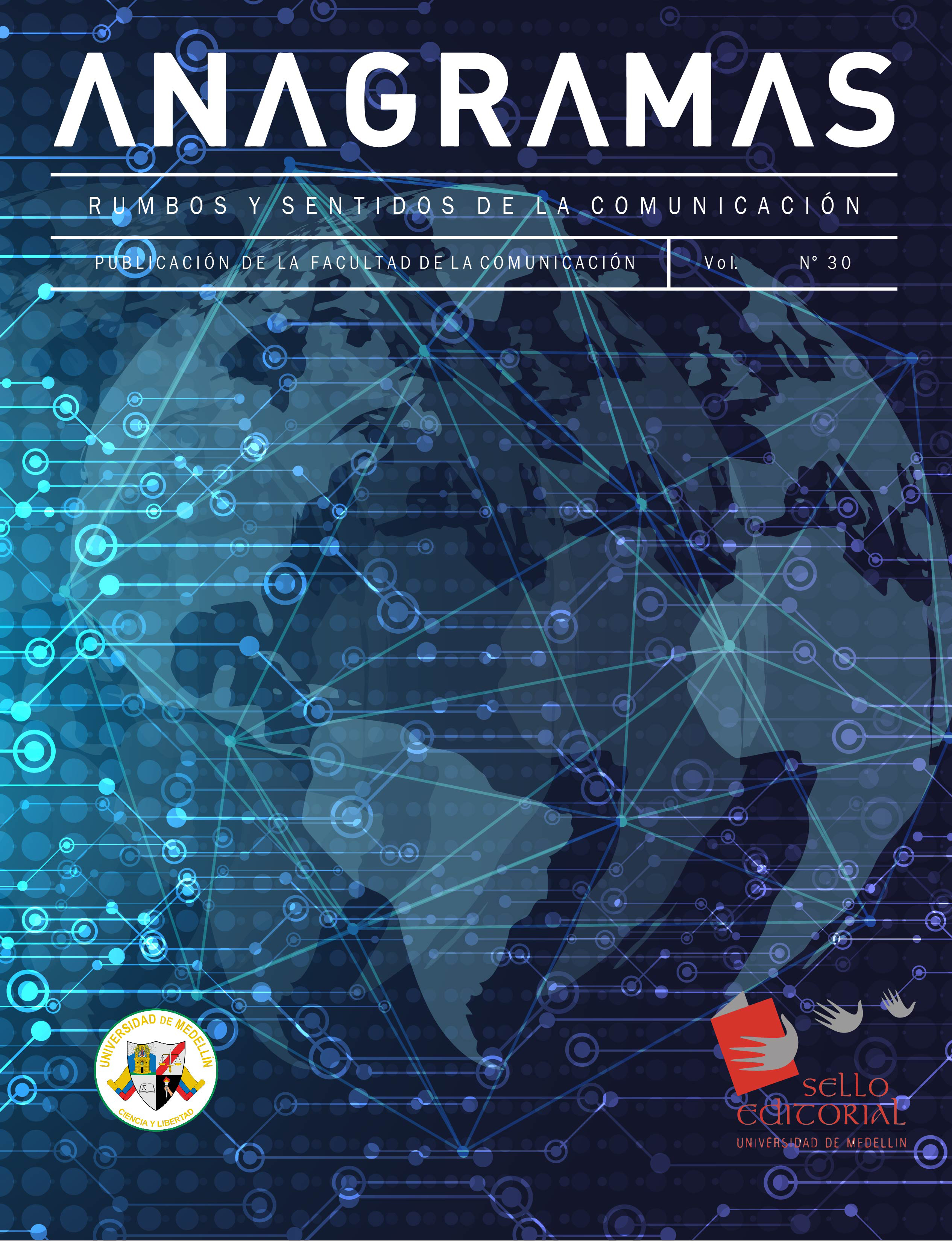Quantitative and Qualitative Analysis of False News about COVID 19 in Colombia
Main Article Content
Abstract
In the midst of the global fight against COVID-19, another evil is occurring: disinfodemia, a term that refers to the massive circulation of false information related to the virus, which helps to increase uncertainty and the number of infected or dead people. In the world, more than 6,000 pieces of information have been disproved, 9 % in Colombia, thanks to the journalistic teams of Colombia Check, La Silla Vacía, Maldita.es and AFP. The purpose of this work is to identify and study, through content analysis, 549 disinformation or inaccurate information that circulated in the country in relation to the pandemic, during the year 2020. A count was made of the false information, as well as of the categories established by the checking media, in order to determine their degree of falsehood, Media and channels through which they circulated, authorship, formats and types of misinformation, among others. The analysis reveals that social networks are 87,4 % of the spaces where false information circulates the most; however, the media and some public figures also contribute to a lower percentage of the problem, with 17 %. The vaccine we propose focuses on the education of future journalists so that they can exercise the necessary verification of the growing amount of information that invades society, and that citizens recognize the veracity of the sources of the information to which they have access. These are ways to combat disinfodemia, which can be as lethal as the virus itself.
Article Details
References
Africa Check, Chequeado y Full Fact. (2020a). ¿Quién es más propenso a creer y compartir desinformación? Luminate.Africa Check, Chequeado y Full Fact. (2020b). La desinformación de la salud. En África, América Latina y el Reino Unido: impacto y posibles soluciones (pp. 1-37). Luminate.
Abela, J. (2002). Las técnicas de Análisis de Contenido: una revisión actualizada. Fundación Centro de Estudios Andaluces.
Berkowitz, D. y Schwartz, D. A. (2016). Miley, CNN and The Onion. Journalism Practice, 10(1), 1-17.
Bernete, F. (2013). Análisis de contenido (cuantitativo y cualitativo). En A. Nobo y M. Antonio (eds.), Conocer lo social: estrategias y técnicas de construcción y análisis de datos (pp. 221-262). Universidad Complutense.
Bontcheva, K. y Posetti, J. (2020). Desinfodemia, descifrando la información sobre el COVID-19. Organización de las Naciones Unidas para la Educación, la Ciencia y la Cultura. https://en.unesco.org/sites/default/files/disinfodemic_deciphering_covid19_disinformation_es.pdf
Bordería, E. (1996). Historia de la comunicación social: voces, registros y conciencias. Síntesis.
Burgueño, J. (2018). Fake news, un fenómeno nuevo con siglos de Historia. Revista Digital Telos,
Telefónica Fundación. https://telos.fundaciontelefonica.com/fake-news-fenomeno-nuevo-siglos-historia/
Díaz, E. (2013). El análisis de contenido como herramienta de investigación [video]. Youtube. https://www.youtube.com/watch?v=Wv7rLBRNJJg
Fernández-García, N. (2017). Fakenews: una oportunidad para la alfabetización mediática. Nueva Sociedad, (269). https://biblat.unam.mx/hevila/Nuevasociedad/2017/no269/8.pdf
Ghebreyesus, T. (2020). Conferencia de Seguridad, Múnich. https://www.who.int/es/dg/speeches/detail/munich-security-conference
González, J. (2001). El paradigma interpretativo en la investigación social y educativa: nuevas respuestas para viejos interrogantes. Cuestiones pedagógicas, 227 - 246.
Higuita, J. C. (2020). Transformaciones desde las rutinas de los grandes medios. Red Colombiana de Periodismo Universitario. https://periodismo.red/proyectos/porlasaluddelperiodismo/
Jenkins, H. (2006). Convergence Culture: Where Old and New Media Collide. University Press.
Johnson, P. (2006). La historia de los judíos. Editorial Zeta.
Latam Chequea. (2020). Información chequeada sobre el Coronavirus. Desinformaciones que desmentimos y medidas oficiales para toda la región. https://chequeado.com/latamcoronavirus/
Ministerio de Salud y Protección Social. (2020). Boletín de Prensa n.° 050 de 2020. https://www.minsalud.gov.co/Paginas/Colombia-confirma-su-primer-caso-de-COVID-19.aspx
Monje, C. (2011). Metodología de la investigación cuantitativa y cualitativa, Guía didáctica. Universidad Surcolombiana.
Nic, R., Scott, J. y Howard P. (2020). Navigating the ‘infodemic’: how people in six countries access and rate news and information about coronavirus. https://reutersinstitute.politics.ox.ac.uk/infodemic-how-people-six-countries-access-and-rate-news-and-information-about-coronavirus
Organización de las Naciones Unidas para la Educación, la Ciencia y la Cultura (Unesco). (2020). Periodismo, Libertad de Prensa y COVID-19. https://en.unesco.org/sites/default/files/unesco_covid_brief_es.pdf
Organización Panamericana de la Salud (OPS) y Organización Mundial de la Salud (OMS). (2020). COVID-19: consejos para Informar. Guía para Periodistas. https://www.paho.org/es/documentos/covid-19-consejos-para-informar-guia-para-periodistas.
Piñuel, J. (2002). Epistemología, metodología y técnicas del análisis de contenido. Estudios de Sociolingüística, 3(1), 1-42. https://www.ucm.es/data/cont/docs/268-2013-07-29-Pinuel_Raigada_AnalisisContenido_2002_EstudiosSociolinguisticaUVigo.pdf
Premio Roche de Periodismo en Salud. (2020). Infodemia: cómo afrontar este ‘virus’ desde el periodismo. https://premiorochedeperiodismo.com/es/2020/04/infodemia-como-afrontar-este-virus-desde-el-periodismo/
Porras Gallo, M. (2020). La pandemia de gripe de 1918-1919. El enemigo temido 100 años después. Revista de Occidente, (448), 95-106.
Robino, C. (2020). ¿Cómo informar responsablemente sobre el coronavirus? Fundación Gabo. https://fundaciongabo.org/es/noticias/articulo/fundacion-gabo-y-facebook-se-unen-para-ofrecer-seminarios-en-linea-sobre-el
Tertuliano, Q. (1889). Apología contra los gentiles en defensa de los cristianos. Tomo CXXV. Librería y Casa Editorial Hernando.
The Associated Press. (2020). Ap style book. Guía tópica de coronavirus. https://www.apstylebook.com/topical_most_recent
Tompkins, A. (2020). Cómo las salas de redacción pueden atenuar su cobertura de coronavirus sin dejar de informar de manera responsable. https://www.poynter.org/reporting-editing/2020/how-newsrooms-can-tone-down-their-coronavirus-coverage-while-still-reporting-responsibly/
Torres, S., Leal, L. y Téllez, Á. (2019). Prensa contrapoder. UniMinuto.
Ufarte-Ruiz, M.J., Peralta-García, L. y Murcia-Verdú, F.J. (2018). Fact checking: un nuevo desafío del periodismo. El profesional de la información, 27(4), 733-741.
Vicol, D. O. (2020). ¿Quién es más propenso a creer y compartir desinformación? Published by Africa Check; Chequeado and Full Fact; International License. https://chequeado.com/wp-content/uploads/2020/02/Quien-Cree-Comparte-Desinformacion.pdf





